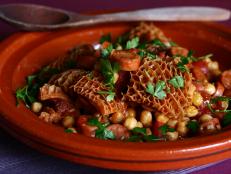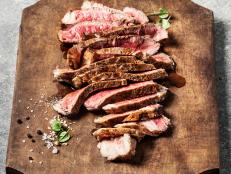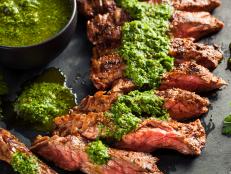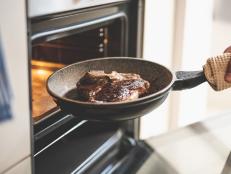What Are Chicken Gizzards?
They taste similar to dark chicken meat. Read on to learn more, including how to cook them.
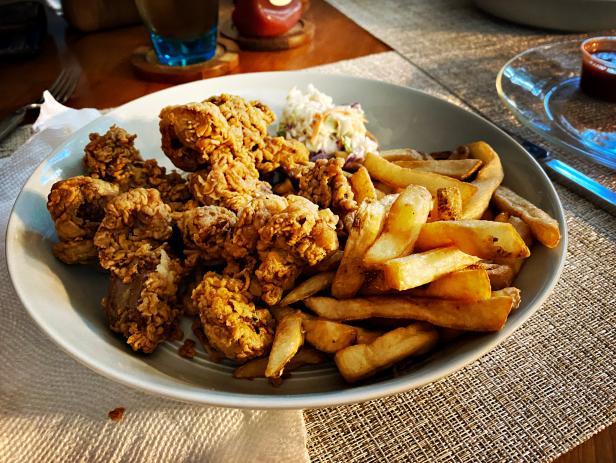
FS/Getty Images
Buy a whole chicken and you’re likely to get a gizzard gratis in the giblet pack. You might also have seen gizzards in the poultry case at the supermarket or local butchers, and if you looked at their bargain price you might have done a double-take. Don’t ignore these slightly odd-looking flavor bombs; they’re remarkably tasty, packed with protein and easy to incorporate —or star — in a number of dishes.
What Are Chicken Gizzards?
A gizzard is part of the chicken’s digestive system, similar to a stomach, and is usually included in the giblet pack when you purchase a whole chicken. They're typically slow cooked and taste similar to dark meat.
Since chickens and other birds don’t have teeth, the gizzard acts as a grinder that pulverizes the food to make extracting nutrients easier. You’ll usually get the firm red gizzard along the other giblets inside a whole chicken, or you can buy them inexpensively at your butcher or most supermarkets. Skewers of grilled gizzards are popular worldwide as street food and they’re also prized for their flavor in soups, stews and sauces and just on their own. In the Southern United States they’re often used in the famous dish dirty rice and also a favorite fried treat.
What’s gizzards’ appeal, and why do they so often fly under the culinary radar? The gizzard packs an outsized amount of flavor and is an excellent low-fat source of protein, but since it’s a hardworking muscle it can be tough. Slow cooking by braising is usually required to soften the gizzard’s muscle fibers. Once they're tender, they're usually further cooked and flavored before making their way to your plate.
What Part of the Chicken Are Gizzards?
Also called the ventriculus or gastric mill, the gizzard is an important part of the chicken’s digestive system that acts as a grinder. The gizzard pulverizes food so nutrients can be extracted by the digestive track. Birds lack teeth, so all of them have this extra stomach-like organ, as do many reptiles and other toothless creatures. When chickens peck food and insects off the ground they also take in things like sand and small pebbles. The gizzard traps these and makes good use of them: When food travels into the gizzard, the collected grit along with the muscle itself help to mash and fragment it.
How Much Do Chicken Gizzards Weigh?
Once cleaned, chicken gizzards weigh about 28 to 35 grams each, or about an ounce or a little more. A pound of gizzards will give you 14 to 16 pieces. But remember that the cleaning process may break each individual one up a bit so you may have some smaller pieces. And if you buy a turkey you may get a gizzard with your giblets as well. Turkey gizzards are much larger, weighing from 2 to 4 ounces or more.
What Do Chicken Gizzards Taste Like?
Gizzards have a meaty flavor that’s much like dark-meat chicken but deeper and a little gamey. Their tasty, concentrated flavor is due to the fact that they’re working muscles, but this also means they start out quite tough. In order to soften the muscle fibers they need to be slowly cooked in liquid (braising) until the fibers soften. Once this is done they can be eaten as they are or further cooked by frying, grilling and more.
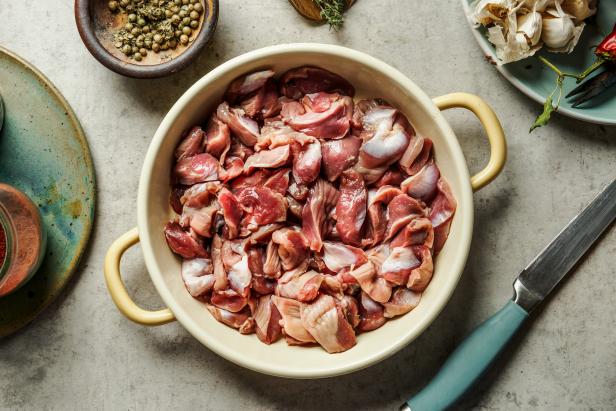
VICUSCHKA/Getty Images
How To Cook Chicken Gizzards
Gizzards start out tough, but once slowly simmered will become nicely tender with just a satisfying amount of chew. If you’re using them in a long-cooking dish like a soup or a stew your recipe may have you just clean and cut them, although sometimes they will be parboiled for a few minutes as well. Most gizzards are sold already cleaned of grit and the yellow lining; if yours aren’t, see "How to Clean Chicken Gizzards" below. And be aware that gizzards will release a deep chicken aroma as they simmer. You might find this deliciously comforting, but if you don’t you should turn on your stove hood or provide other ventilation; adding a couple bay leaves may soften the aroma.
Step 1: Prepare Your Pot
Make sure your gizzards are already cleaned (see below); discard any bits of tough yellow lining if there are any. Place the gizzards in a pot and add water to cover by 1 inch. You can salt the water if you like and add aromatics: Bay leaves, a clove or two of garlic, a bit of celery or onion are popular.
Step 2: Simmer
Bring to a simmer over medium heat. Partially cover the pot, adjust the heat and cook at a bare simmer until the gizzards are tender, anywhere from 1 to 1 1/2 hours, although some recipes may direct you to do this for several hours. Add more water if needed.
Step 3: Test for Doneness
At about the 1-hour mark, cut into a gizzard to test it. You can cut off a little piece and bite into it if you like — depending on your dish, you may like a bit more or less chew. Continue cooking until you like the tenderness of the gizzards.
Step 4: Cool
Drain the gizzards, reserving the water they cooked in if you like; it should be deeply chicken-like in flavor and can be used as chicken broth. Cool the gizzards to room temperature, then pick through them and remove any tough gristly bits with your fingers, a paring knife or kitchen shears. They’re now ready to cook in a recipe, or you can refrigerate them for 3 to 4 days.
You can fry the gizzards in a seasoned flour or breading just like you would fried chicken, or toss them in a marinade, thread them on skewers and grill them until browned and heated through. You can chop them finely and add them to any number of dishes like rice, lasagna, tacos, hash, tomato or Bolognese sauce for pasta or just about any dish that could use some meaty chicken flavor.
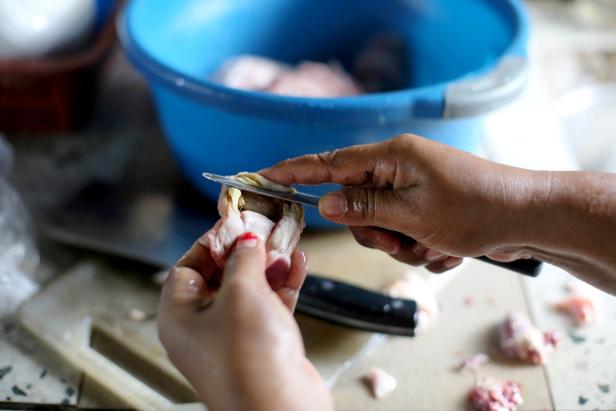
Alex Liew/Getty Images
How to Clean Chicken Gizzards
Gizzards you purchase are likely to be cleaned, but if they’re not you can do it yourself with a sharp knife. It’s pretty easy to tell if yours have been cleaned: An uncleaned gizzard will be slightly football shaped, while a cleaned one will have been opened into two halves connected in the middle. If yours aren’t cleaned here’s what to do:
Step 1: Open and Remove Grit
Use a sharp knife to make a deep slit into the gizzard. This will expose the grit; place the gizzard under running water and use your fingers to help dislodge and rinse it away.
Step 2: Remove the Yellow Lining
Use your fingers to peel away the yellow lining. A paring knife can help you remove any pieces that stick.
Step 3: Rinse and Store
Rinse again and pat very dry. If you’re not cooking the gizzards immediately store them in an airtight container in the refrigerator for up to 3 days. Or you can place them in a resealable freezer bag, remove excess air and freeze for up to 6 months.
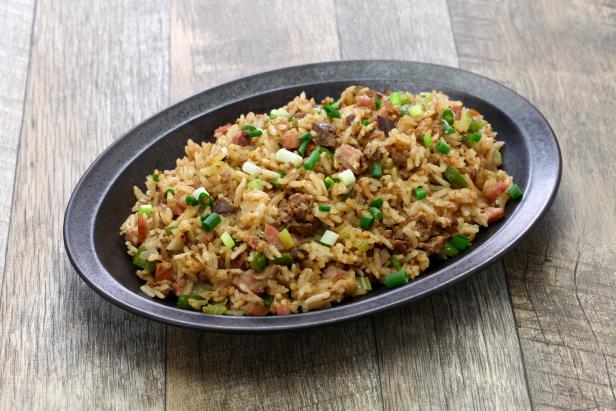
bonchan/Getty Images
What to Do With One Chicken Gizzard
Bought a chicken for roasting, and find a single gizzard in the giblet bag? You might be tempted to toss it, but there are some good things you can do with this tasty morsel. Here are our top four suggestions, and they’ll work for a single turkey gizzard as well:
Make Homemade Stock. Gizzards lend stock deep flavor. Combine your gizzard with the carcass and bones of your roasted chicken, any other giblets except the liver (it’s too strongly flavored), a carrot, celery stalk, garlic clove, half an onion and 2 quarts water and simmer uncovered for about 3 hours.
Mince and Sauté It. While gizzards can be very chewy whole, mincing them gives you some extra options. Dice the gizzard up, fry it over medium heat in a small skillet and add it to tacos, hash, tomato sauce, a stew or any other place you want deep meaty flavor. You can add it to gravy base as well; just strain the sauce before serving.
Freeze It. Pop it in a resealable freezer bag, remove excess air and freeze it. Add another gizzard every time you get one in a chicken. You’ll have up to 6 months to use them in homemade chicken stock (see above), in dirty rice or any other meaty dish, and if you get around 8 you’ve got a reasonable amount to make deep-fried gizzards or grilled gizzards.
Feed It to Your Pet. Most dogs and cats will love this protein-rich treat. Boil the gizzard just until cooked, about 15 minutes. Cool and chop and you’ll have a terrific snack for a fur friend.
Related Links:


























